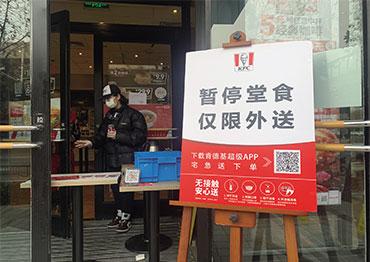Attracting new customers is another headache. Qing Yong, founding partner of Fanqieziben, a catering industry investment firm, believes that demand for dining out will not change. “It’s the scenario that has changed. Catering enterprises need to figure out how to transcend traditional industry boundaries,” Qing said.
Consumption patterns and dining scenarios have diversified since the pandemic, partly because of the boom in delivery platforms. Takeout has since been the go-to market for additional revenue streams.
Qing noted that in the past two years, many companies have invested heavily in expanding services beyond eat-in dining, particularly delivery services. He said such avenues could help restaurants and grocery retailers recoup losses, as delivery already accounted for a large share of their business during the pandemic.
For example, seafood restaurant chain Yunizaiyiqi and dumpling brand Xiongdaye saw growth as the catering industry suffered overall thanks to their takeout service offerings. Xiongdaye opened over 100 new locations in March and April. Yunizaiyiqi has opened over 300 locations a year since its founding in 2017. It now has over 1,400.
Major franchises including hotpot chains Haidilao and Xiabu Xiabu and Starbucks upped their product lines, while more Chinese food brands are jumping on the bandwagon.
According to Qing, these changes in consumption are influencing location choices for restaurants. In the past, franchises used to prefer big shopping malls or commercial centers to guarantee foot traffic and maintain brand influence. But commercial property development has stagnated in recent years, while rising rents and decreased foot traffic have taken the shine off shopping malls.
In contrast, local community-based locations boast multiple advantages. There are over 100,000 urban communities across China, according to China’s Ministry of Civil Affairs, while there were 6,300 shopping malls in operation at the end of 2021, data from the Chain Store & Franchise Association released in early June shows. Besides, communities usually offer longer contracts than shopping malls, giving small businesses a chance to become more established. Rents are lower and more stable.
“In the future, more franchises will likely set up shop in communities,” Qing said.
Wen Zhihong said the recent dip does not mean the overall industry is in decline. “People cannot do without food, so the catering industry will never fade. Instead, it will keep expanding as the economy grows,” Wen said.
Zhu Xiaohu, managing director of GSR Ventures, noted in a 2021 speech that the scale of offline catering would reach 10 trillion yuan (US$1.5t) in 10 years. “If half the restaurants are chains, then they can share half the market. If there are 500 chains, then each could net 1 trillion yuan (US$148.4b). It’s an opportunity for China’s offline catering industry,” Zhu said.
Despite the pandemic, the number of newly registered food and beverage companies rose in both 2020 and 2021, and increased 10.5 percent year-on-year in the first quarter of 2022, data from business data provider Qichacha shows.
But for now, the situation remains challenging. Li Weihua told NewsChina that the threat of resumed pandemic restrictions still dangles above the heads of restaurants nationwide.
“It seems like it depends more on luck right now,” a restaurant supplier in Beijing said.

 Old Version
Old Version


